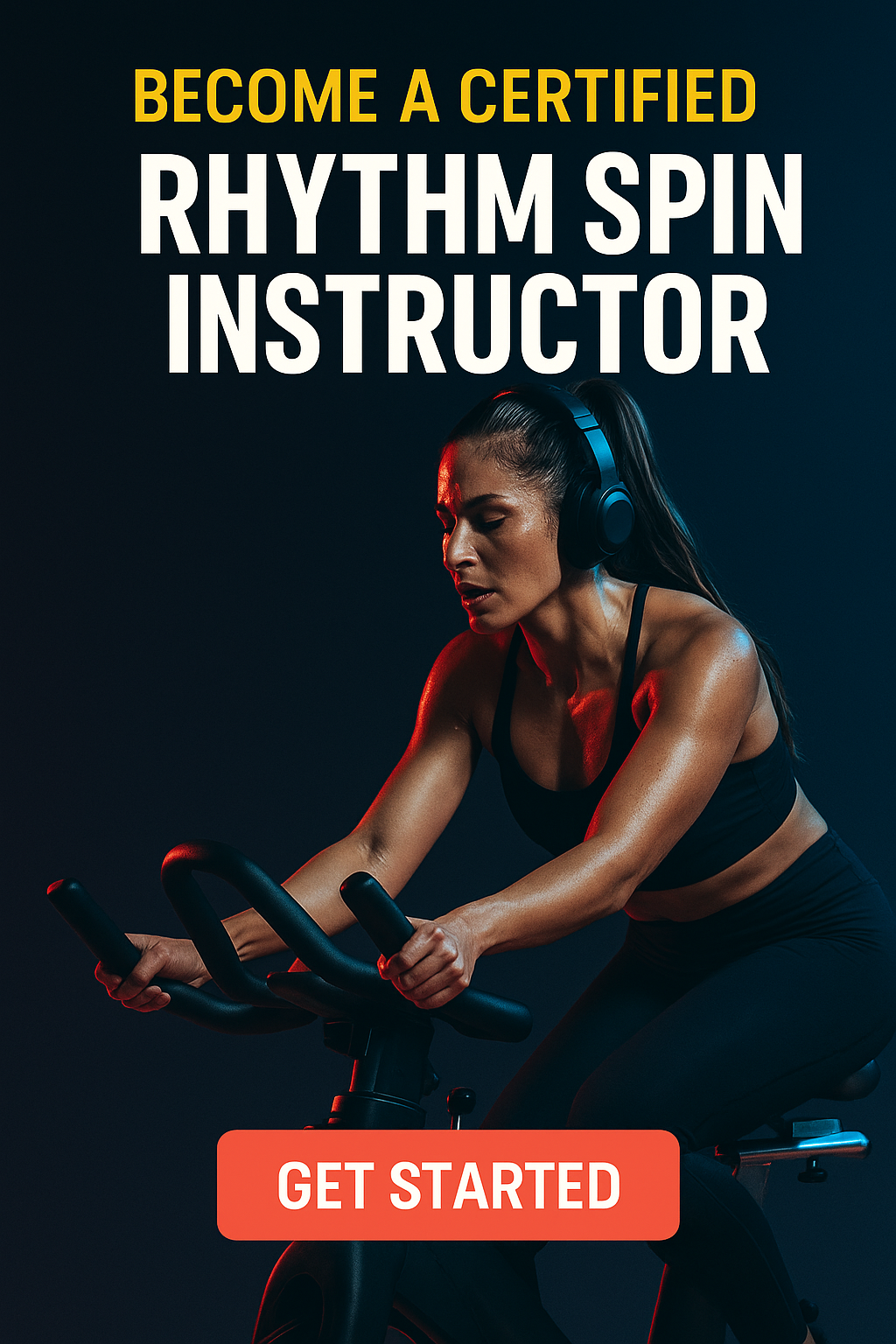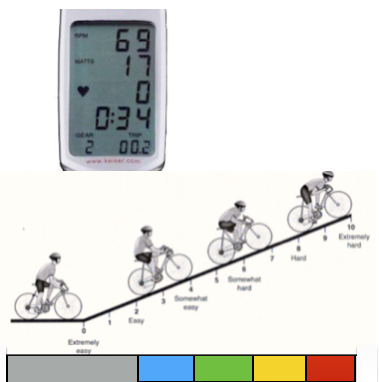
It is brilliant to get feedback on gears and watts during our cycle classes but one common remark is that there are inconsistencies between one bike’s computer and the next when using Keiser and Schwinn. So how do we work with the computers if they are not 100% accurate?
Most Indoor fixed gear bikes that display gears and watts are not 100% accurate and therefore recommending a gear, one size fits all approach won’t meet you or your cyclists expectations. All fixed gear bikes with computers that display Watts / Gears are calibrated differently even though they claim to be factory set. This means that each bike will have a different feel using a nominated gear. The settings on fixed gear bikes lose calibration, so enforcing a particular gear or watt will not ensure the cyclists are working in the correct zone. Instead of enforcing a gear or wattage, offer a range of watts and gears to work within or ask cyclists to set a base gear/watt range kinesthetically using a perceived exertion chart. Perceived exertion charts offer a number, a description and a kinesthetic description. There are many available, the trick is to use one that is simple and easy to understand. A chart displaying colour is very effective. Perceived exertion charts can be used if heart rate monitors and power meters are not available but the best result is when RPE charts are used in conjunction with biofeedback, gears and watts.
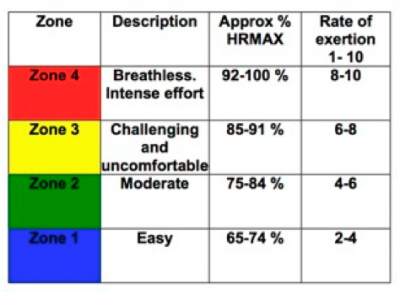
It is also likely that cyclists attending classes will be using a different bike each time, which will be calibrated differently. We wouldn’t want to encourage the same person using the same bike each class as this may create a competition to race to the best bike. “This is my bike” If the feedback we are getting is inaccurate then it is reasonable to suggest we should not rely on the computers 100%, instead use the biofeedback after we have set a base level kinesthetically.
Below are some tips and suggestions to work around the inconsistencies.
1. The Cadence display. The Cadence displayed will be correct as this is a simple process of counting the revolutions per minute but if you are not sure do a manual cadence count. Put your hand above your knee and count the amount of times the hand hits the knee over ten seconds. 60 RPM is ten counts over ten seconds. 90 RPM is 15 counts over ten seconds.
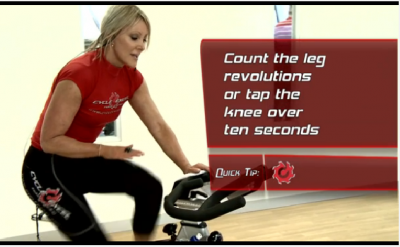
2. The Gear display. A one size fits all will not meet your expectations. If the gear that is displayed is not accurate then why enforce it? Do not enforce a gear, instead give a range of gears to work within. These bikes will be calibrated differently, so enforcing a gear will not mean that the cyclist attending your training session will be using the same amount of resistance as the person sitting beside them. Use a kinesthetic teaching technique to find the base gear first. “As all the bikes are calibrated differently, we need to find our base level gear and watts reading on our bikes. Cycle between 70 – 90 RPM and cover the computer. Now imagine a scale of 1-10! 10 is a maximum effort where it is difficult to breathe. Now add adequate resistance and continue cycling between 70-90 RPM so that you feel that you are at a level 3-4. Now that you have established your base level, the blue Zone have a look at your watts and your gear display. This is your starting point, your blue zone. We have four zones to work within, the next level is the green zone, followed by the yellow zone and finally the Red zone. The red Zone is close to a maximum effort.”The goal today is to stay above the blue zone”
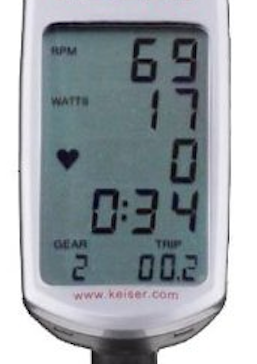
3. The Watts display. This is meant to display your power output. Once again the watt meters on both the Schwinn and Keiser bikes will vary from one bike to the next. To get the most out of the watt meter ask the cyclists to find their base coaching kinesthetic cues and then focus on increasing the watts during the class and perform a watt ladder. Use a teaching technique to guide the cyclists to find their base level. First establish the blue zone, then add 5-10 watts to start moving into the Green zone. A cue for watts could be; “You have now established your blue zone watts, we will be working within four zones today, Zone 1, 2, 3 and 4. You can now move up from your established base blue zone effort”.You, the instructor and trainer can now say cues such as “add 10 – 20 watts from your base. Add 20 watts from your base for 30 seconds, GO!
“Add 10 watts from your base every minute” “cycle at 90 RPM, Keep adding 10 watts every minute until you can’t maintain the speed any longer”.
You could also ask your cyclists to establish a gear watt level for the green zone by finding a level 5 out of 10. The Kinesthetic cue; Moderate, talk in short sentences.
Currently the Indoor bike with the most accurate power meter is the Watt bike.
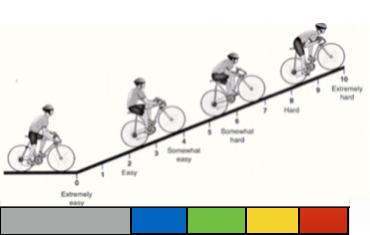
Find your Blue Zone base with perceived exertion and work from there.
4. Give a range of gears and watts to work within. Everyone wants to feel successful. Not everyone wants to work in the red zone and there will be cyclists who are training for health and wellness not just for speed and power, so offering a range of options and zones is more likely to suit most.

Summary. When teaching on a bike with a fixed gear with inaccurate computer displays, a helpful teaching tip is to ask participants to add a good amount of load prior to commencing the warm up without acknowledging the computer. Add load so the pedals feel ‘sticky’. ‘Sticky pedals’ is your starting point. Ask the Cyclist to keep the speed between 70 – 90 RPM and cover the gear/watt reading. Let them find their base level kinesthetically first and use a perceived exertion scale. Ask your cyclists to imagine a scale of exertion between 1-10, and to choose a gear that would represent a perceived exertion level of 3 or 4. This is your starting gear! Do the same with the watt reading. The base level is your starting point and do not go below this number. A watt ladder can be performed from the base level ascertained. For example imagine your base level was 150 watts, it would be a simple manner of increasing the watts by 5 or 10 or more at suggested time intervals. Start with a Kinaesthetic cue to find the base level and work from there.


